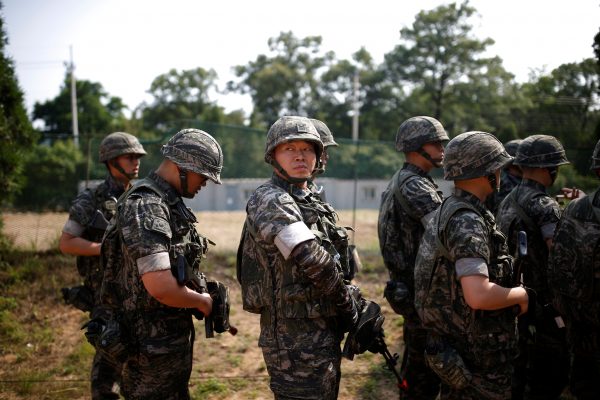South Korea is a US ally in East Asia that pulls its own weight. Seoul spent 2.6 per cent of its GDP on defence in 2018, compared to 1.2 per cent for Germany and 0.9 per cent for Japan — a figure that surpasses NATO’s 2 per cent benchmark. South Korea currently has one of the top 10 largest defence budgets in the world at over US$40 billion and is on track to become one of the top five or six by 2022.
The US$923 million that Seoul contributed for the United States Forces Korea (USFK) does not include the US$10 billion that the country spent to build Camp Humphreys in Pyeongtaek, nor the nearly US$20 billion that South Korea spent on US weaponry and military equipment in the last decade. And contrary to popular misconceptions in the United States, it is South Korea’s troops — not US troops — that stand as the first line of defence against a potential act of North Korean aggression along the Demilitarized Zone.
The United States may back off from its demand for a fivefold increase in the coming negotiations but Seoul will long remember the boorishness with which it approached the cost contribution issue. A sensitive matter like cost-sharing between close allies is best handled behind the scenes in order to maintain an outward posture of solidarity. Instead, the United States chose to negotiate loudly and in the open, angering South Korean decision-makers and provoking public opposition.
In January, US Secretary of State Mike Pompeo and US Defense Secretary Mark Esper took the extraordinary step of publishing a joint op-ed in the Wall Street Journal calling for South Korea to pay more. With no basis, Pompeo and Esper claimed that ‘South Korea bears no more than one-third of the costs most directly associated with the stationing of US forces’. Even if this were true, the demand for a fivefold increase in payments would be equivalent to asking South Korea to shoulder 167 per cent of the cost of stationing USFK.
Needless to say, these moves are not being received kindly. While the South Korean public still supports hosting US troops, the opposition to the fivefold hike is bipartisan and overwhelming.
Washington is unwise to endanger its alliance with Seoul this way. As China emerges as the United States’ primary rival in the coming decades, the importance of the alliance with South Korea will only increase.
To be sure, it far from true that the US–South Korea alliance is on its last legs and the oft-made claim that South Korea may join the Sinosphere is overstated. But it is true that South Korea is significantly exposed to pressure from China, its largest trading partner. When South Korea hosted the US military’s THAAD missile defence system, the subsequent Chinese economic sanctions caused billions of dollars in damage to the South Korean economy — damage that the United States did not help to mitigate.
How will Seoul act in a world in which it must face the increasingly assertive and illiberal China without the assurance that its most important ally will come to its aid? The quiet arms race that South Korea has been pursuing in recent years hints at a response. Nearly as soon as Trump was elected as US President in late 2016, Kim Hyun-chong — who is now a senior South Korean presidential advisor — outlined the potential response if President Trump pursued a significant increase in South Korea’s defence contribution.
Kim believed that the increased contribution may be a bargain if South Korea could receive five things in return: the ability to re-process nuclear waste, a dollar–won currency swap, the technology to construct a satellite launch vehicle, the ability to build a 3000-ton nuclear submarine and the ability to build ballistic missiles with a range greater than 800 kilometres.
Since Kim entered the Blue House, South Korea has been going precisely in this direction. With the COVID-19 pandemic threatening the global financial market, Seoul and Washington recently entered into a US$60 billion currency swap facility. On the military equipment side, the South Korean Navy officially announced its plan to acquire nuclear submarines in October 2019. News reports indicate that South Korea and the United States have reached a tentative agreement to relax the restriction on South Korea’s missile program.
The capacity of this military equipment vastly outpaces the ostensible reason for acquiring them —deterring North Korea. The desire to acquire them indicates that Seoul is preparing for a future without the US security guarantee.
Some in Washington may welcome this development. But South Korea’s increased military capability may prove to be a double-edged sword. A highly militarised South Korea is not necessarily in the US national interest and may cause tensions to escalate in the region. For example, there is a risk that the relationship between South Korea and Japan could deteriorate further in the next decade to the point where they begin taking hostile military postures akin to those of India and Pakistan.
It is not too late for the United States to turn away from this result. In November 2020, the US electorate will have the opportunity to remove Donald Trump from the presidency and end his brand of diplomacy that alienates allies around the world. Should Trump get four more years in the White House and additional chances to extort South Korea for defence contributions, the US-South Korea alliance will truly be in trouble.
S Nathan Park is an attorney at Kobre & Kim LLP, Washington DC.

